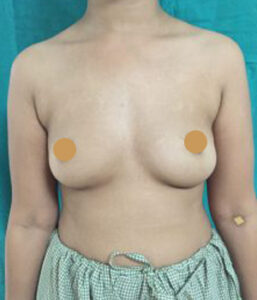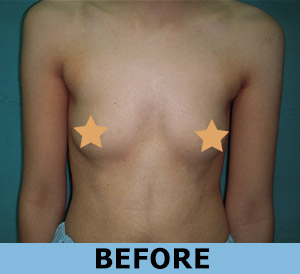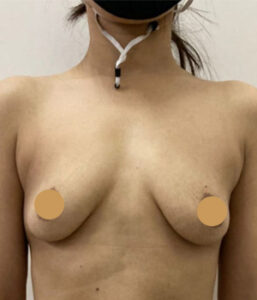
Before

After

Before

After

Before

After

Before

After



Before

After
BREAST AUGMENTATION SURGERY IN DELHI/NCR
What is Breast Augmentation Surgery?
Full looking and perky breasts make a woman feel more complete. Thanks to advances in technology, this can be a reality for any woman. Breast Augmentation surgery is a surgical procedure to enlagre breasts. More importantly, breast surgery implants have been proven to be safe and do not affect the breast functions. Nor do they cause or increase the chance of breast cancer or tumors. Even breast feeding can be done normally later.
The US FDA has approved cohesive gel silicone implants for breast augmentation surgery. Implants are available in various sizes and the right choice of the implant depends on the chest size, amount of existing breast tissue, and your personal choice.
The scars of surgery are well hidden and the breasts look and feel natural.
A state of the art operation theatre employing sterile techniques, a complete range of sophisticated instruments and above all meticulous care during surgery are key to avoiding complications.
Desk jobs and light physical activity can be resumed in a few days.
The surgery is done as a daycare procedure in our facility in Delhi/NCR India. Upper body exercises and fondling of breasts are to be avoided for a month.
The operation is carried out in our Breast Augmentation Treatment in Delhi/NCR under general anesthesia a daycare surgery. An implant (prosthesis) is placed through an incision, under the breast tissue, or under the muscle. The incision can be made under the breast, around the nipple or in the armpit. It generally takes two to three hours to complete the entire procedure. A breast implant is composed of an outer shell filled with saline (saltwater). The outer surface may be smooth or textured, and implants come in various shapes to meet the individual woman’s needs.
Types of Breast Implants Surgery
- Breast Implants can be broadly classified as SALINE and SILICON implants depending on its contents.
- Silicone implants have a cohesive matrix of silicone gel inside. The cohesive silicone gel implants are preferred in most cases as they look and feel more natural.
- Silicone implants are available in the round or circular as well as the anatomic or ‘teardrop’ shape. These are also available as low, moderate and high profile.
pre surgical evaluation
A clinical examination is performed to assess the breast architecture including size, proportion to rest of the body, symmetry, and any other anomalies. The surgical plan will depend on the findings of the clinical examination. The presence of any breast diseases also needs to ruled out.
The size or volume of the implant to be used will depend on 5 key factors :-
- Your expectation/desire
- Amount of existing breast tissue
- Any drooping of the breast
- Chest size
- Skin envelope of the breast
Blood tests, a baseline mammogram or ultrasonography of the breasts and other tests for anesthesia form part of the pre surgical evaluation.
Access / Incision for Breast Enlargement
Two most commonly used approaches to breast augmentation are the circum areaolar approach and the infra mammary crease approach.
In the infra mammary approach, a fine 5 cm incision is made beneath the breast in such a way that the final scar falls in the breast crease. As the final scar falls in a natural fold, it fades well over a period of time. The infra mammary fold is the most hidden portion of the breast and most women prefer to have the access from this area.
In the circum areaolar approach, the incision is made in the lower half circle of the areola. The advantage in this approach is that the final scar blends in well in the natural color interface of the areola and breast skin.
Trans axillary approach employs an incision in the crease in the under arm area. TUBA or Trans umbilical breast augmentation uses access from the navel using endoscope. Both these approaches are possible with saline implants, the use of which is decreasing since USFDA approval for cohesive gel implants.
Breast Enlargement Procedure
The surgery is done under general anesthesia. The surgery takes about 2 hours to complete. The space / pocket for the implant is created in any of the following locations – 1. below the gland (sub glandular), 2. Below the muscle (sub muscular), or 3. Dual plane (where the upper half of the implant is below the muscle and lower half below the gland). The decision to create a particular pocket in each case is made considering the tissue characteristics of the breast and the type of implant.
The pocket is created with meticulous technique using special illuminating devices and magnification. The adequacy of the pocket is checked during the surgery using disposable sizers.
Small tubes to drain off any collecting fluid may be placed, which are removed in 24 – 48 hours.
Post Surgery
The post-surgery period following breast implant surgery is generally pleasant and well-tolerated. Minor discomfort, the feeling of stretch, swelling and bruising can be expected. Most patients are able to start normal daily activities from the next day and return to office work in 2 – 3 days time. Decreased sensation over the breast can occur and usually improves in a couple of weeks.
The 24 Hour Breast Augmentation Surgery/ Enlargement
For most of our patients, getting back to work early is a priority. Thanks to an innovative post operative regimen designed by Dr. Pankaj, return to work the very next day is possible now. A special set of exercises started on the first post operative day helps to reduce the discomfort and tight feeling after surgery.
Complications are rare following breast augmentation. Early complications include collection of serous fluid or blood, sensory changes, infection, implant mal position.
Infection can occur in the early post operative period. The infection rate in breast implant surgery is less than 1%. Antibiotic treatment results in resolution of the infection in most cases. In cases where the infection has not subsided, the implant will have to be removed and inserted few weeks after complete resolution of the infection.
Capsular contracture can occur as a late complication. The body forms a covering around the implant. This capsule can thicken and distort the implant in some cases. Capsular contracture incidence at our centre has been much lower than international standards, thanks to our preventive measures. Breast exercises instituted 2 weeks after the surgery and continued for a year go a long way in preventing capsular contracture.
